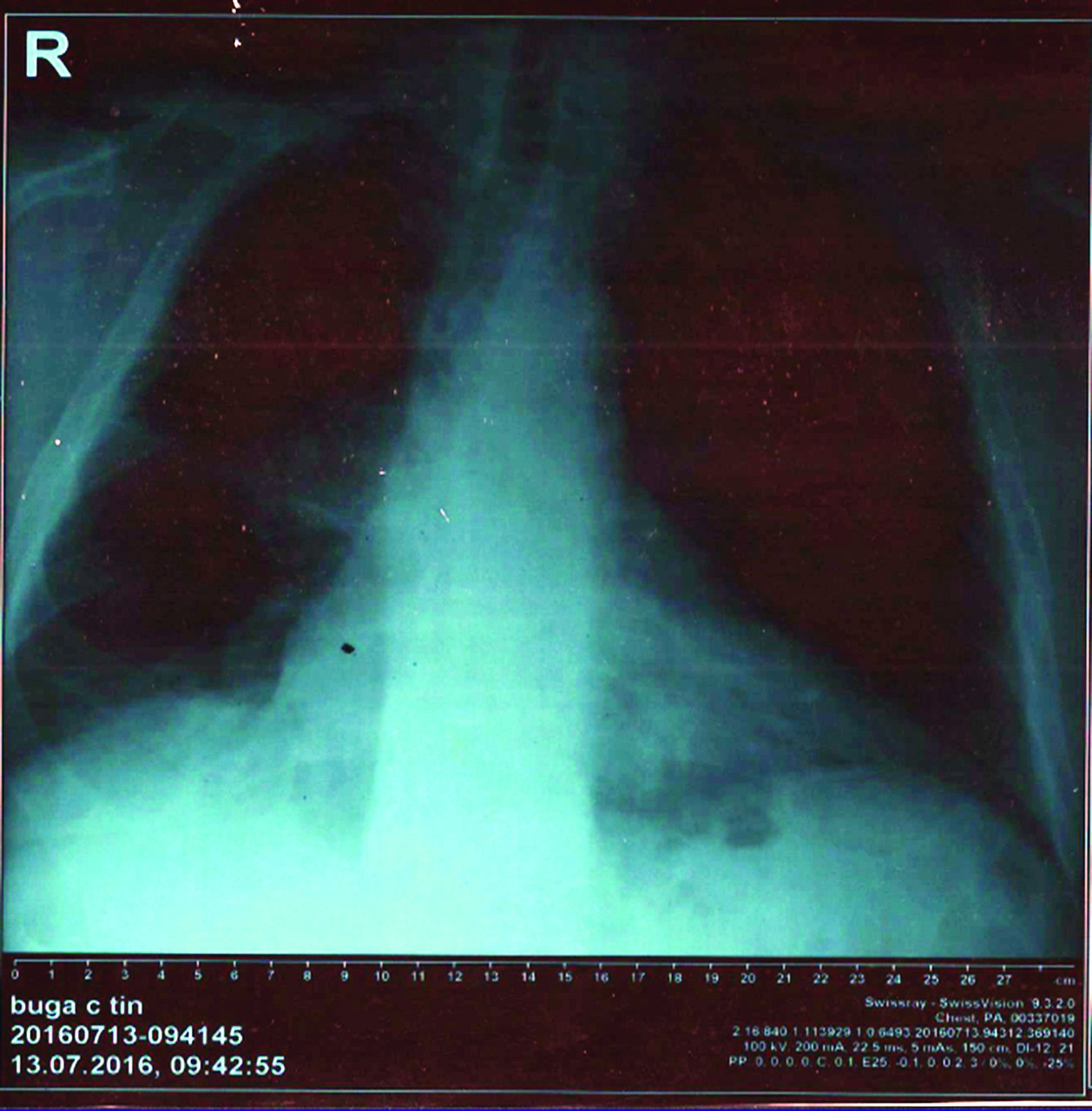Non small-cell carcinoma is one of the cancers that do not yet have a clear advantage in the targeted therapy. Although despite the results of new therapies being awaited, some studies have revealed new drugs that appear to change the evolution of this incurable disease. The case we are presenting it is illustrative for possibilities to treat this type of cancer in Romania. Current treatment for this form of cancer is: chemotherapy in first line which is represented by gemcitabine in combination with cisplatin or carboplatin. In the second-line docetaxel is recommended. Third line is not well defined at us because we did not have in current use afatinib, necitumumab or immunological agents. In this case we have used vinorelbin in mono-therapy and erlotinib. The peculiarity of the case consisted that had a sensibility to more lines of chemotherapy and radiotherapy and ultimately though I had not a determination of epidermal growth factor receptor, patient response to erlotinib.
Carcinomul pulmonar scuamos
Squamous cell carcinoma of the lung
First published: 07 martie 2017
Editorial Group: MEDICHUB MEDIA
Abstract
Rezumat
Cancerul pulmonar fără celule mici scuamos este unul dintre cancerele care nu are încă un avantaj cert în cadrul terapiei țintite. Deși rezultatele cu terapii noi se lasă așteptate, unele studii au relevat noi medicamente care par să schimbe evoluția acestei boli incurabile. Cazul pe care îl prezentăm este exemplificativ pentru posibilitățile actuale de tratament în România pentru această formă de cancer. Chimioterapia de elective în linia întâi este cea reprezentată de gemcitabine în asociere cu cisplatin sau carboplatin. În linia a doua se recomandă docetaxel. Linia a III-a nu este bine definită la noi, deoarece nu avem încă în uz curent afatinib, necitumumab sau agenți imunologici. Particularitatea cazului o reprezintă faptul că a fost sensibil la mai multe linii de chimioterapie și la radioterapie, iar în ultima instanță, deși nu am avut o determinare de receptor al factorului epidermal de creștere, pacientul a răspuns la erlotinib.
In Europe, similar trends have occurred in men, while in women, both SCC and adenocarcinoma are still increasing”(1).
Epidemiological data show recently that overall survival (OS) gains more pronounced for patients with adenocarcinoma histology, less for patients with squamous-cell tumors(2).
In this context, our case is relevant for the possibility of treatment in Romania.
We present the case of a 62-year-old man, smoker (20 pack/year), with the following comorbidities: arterial hypertension, hyper colesterolemya, and diabetes mellitus.
Concomitant medication: tertensif, perindopril.
The main symptoms were: loss of appetite, fatigue, shortness of breath, cough.
Second line chemotherapy
11.02.2016: after approximately 5 months of remission, we had progressive disease and we initiated the second line chemotherapy: Docetaxel 75 mg/m2. Docetaxel was administered (2 cycles) until 24.03.2016, when it was interrupted because of its toxicity (cough, dizziness, asthenia, lack of appetite).Mono-chemotherapy with oral Vinorelbine 2.3 mg/m2 was indicated between 25.05.2016 and 31.08.2016.
CT revealed stationary disease. A new CT exam was performed on 18.05.2016.
In 1.06.2016, we initiated the treatment with Erlotinib. Because the CT was not repeated in June, the patient underwent a chest X-ray (18.06.2016), repeated in 19.09.2016. The last X-ray revealed a reduction in mass tumor.
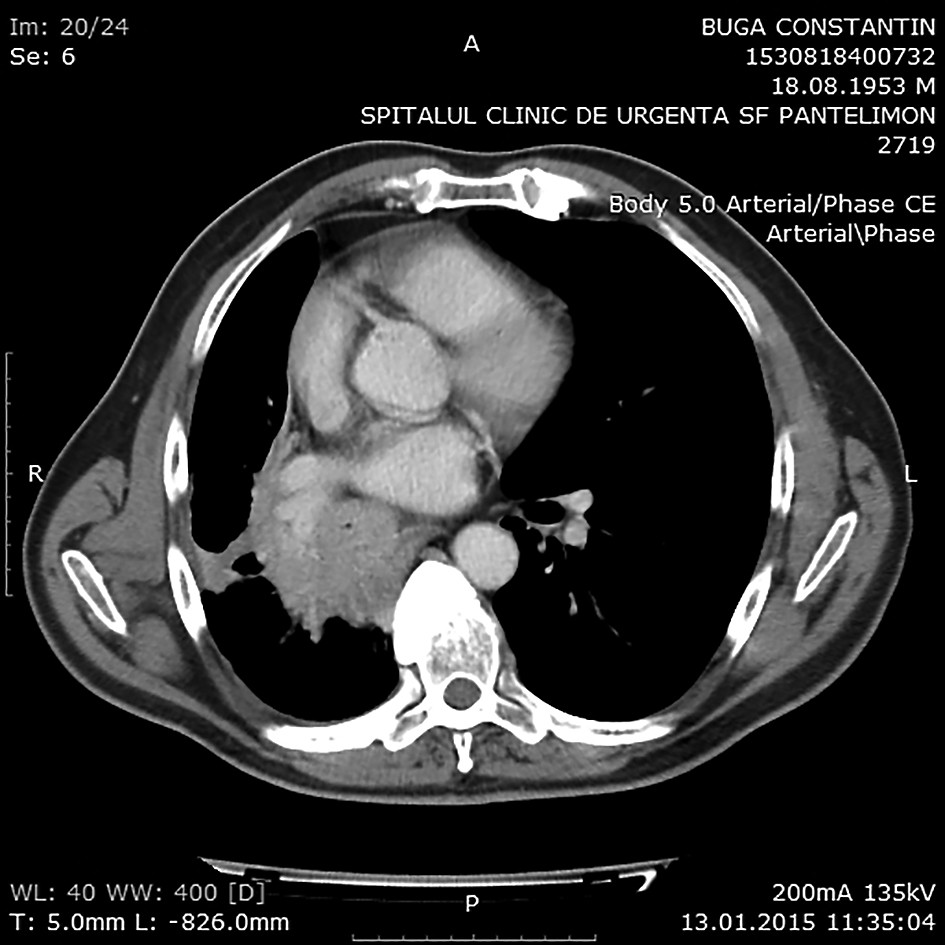
which causes atelectasis of medium lobe, and partial right lower lobe.
Thoracic mediastinal lymphadenopathy. Pleural right effusion in moderate quantity
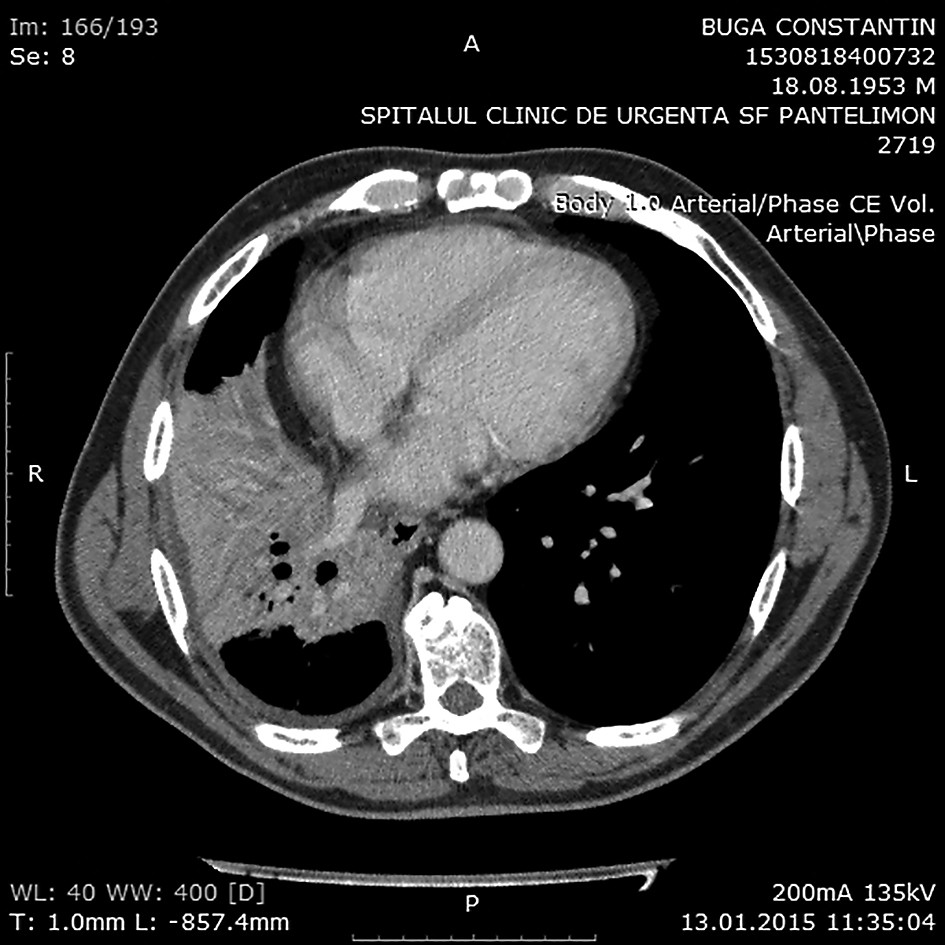
and bronchoscopy with biopsy were determinant for the diagnostic of squamous cell carcinoma of the right lung.
First line chemotherapy was administered between 19.02.2015 - 4.05.2015 and consisted in:
Gemcitabine 1250 mg/m2 (day 1 and 8) + Carboplatin AUC 5 (day 1), in cycles of 21 days.
After that, radiotherapy was administered between 19.05.2015 - 29.06.2015
Comments
Patients with Squamous Cell Carcinoma (CCO)“In patients without actionable mutations and squamous cell carcinoma histology, the recommended options include platinum-based doublets or the platinum-based doublet gemcitabine and cisplatin combined with necitumumab”.
Patients with squamous NSCLC had improved OS when treated with cisplatin/gemcitabine vs. cisplatin/ pemetrexed (10.8 vs. 9.4 months; p=.05).
Necitumumab, an anti-EGFR monoclonal antibody, is approved by the FDA as first-line treatment of metastatic, squamous NSCLC, in combination with gemcitabine and cisplatin.
Cisplatin vs. carboplatin
- The benefit of cisplatin vs. carboplatin for the treatment of advanced NSCLC is controversial.
- Treatment-related adverse events should be considered during treatment selection.
Carboplatin associated with thrombocytopenia.
Carboplatin-based regimens were most often used in US regardless of comorbidities.
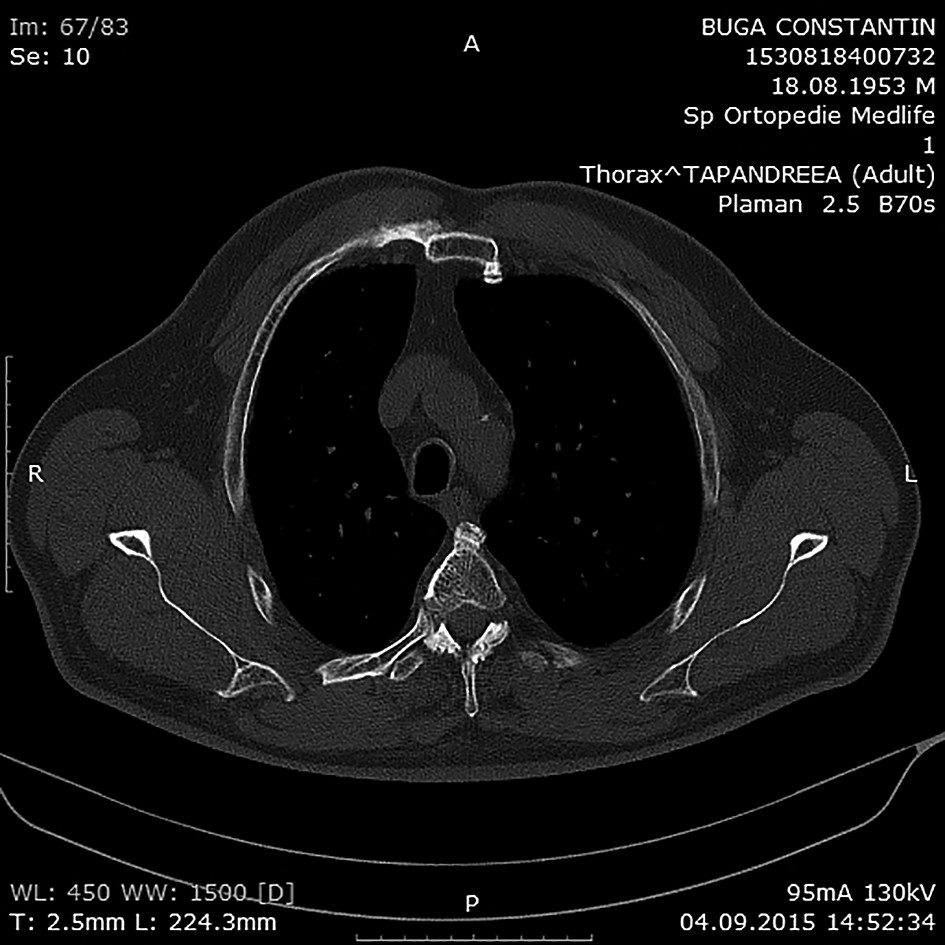
infra hilarious and lodge Baretty. Favorable global aspect post radio-chemotherapy.
The totally disappearance of the right pulmonary opacity
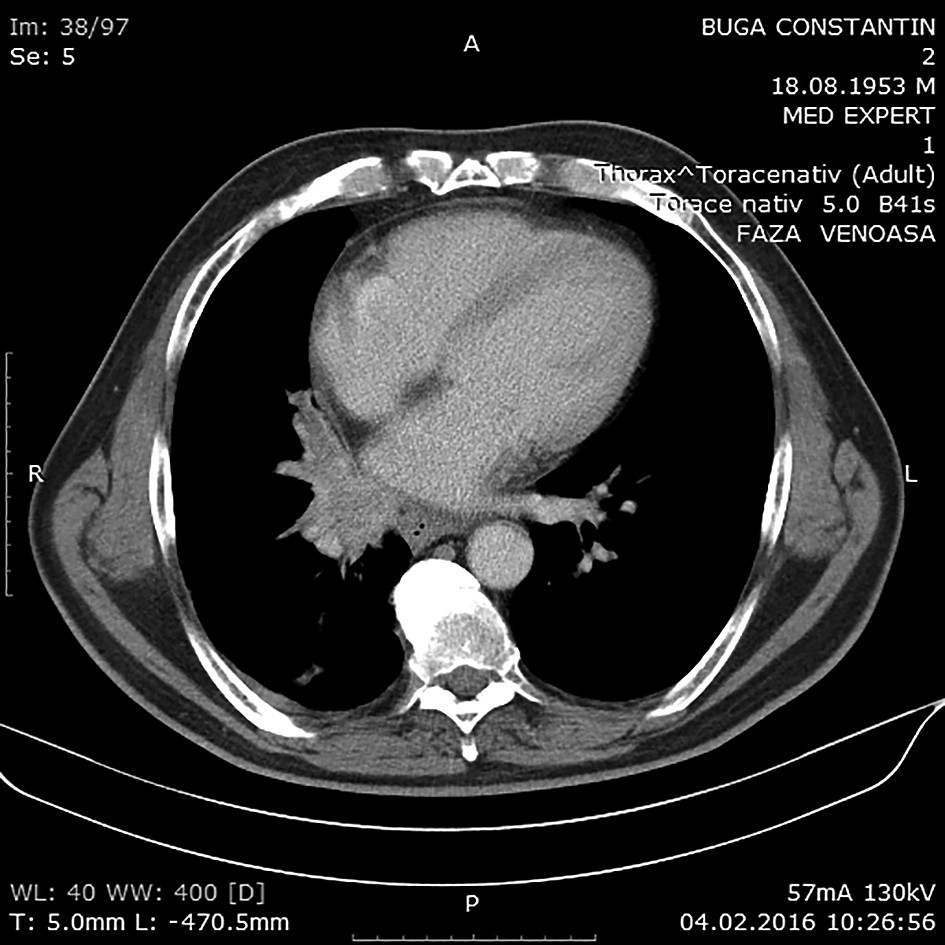
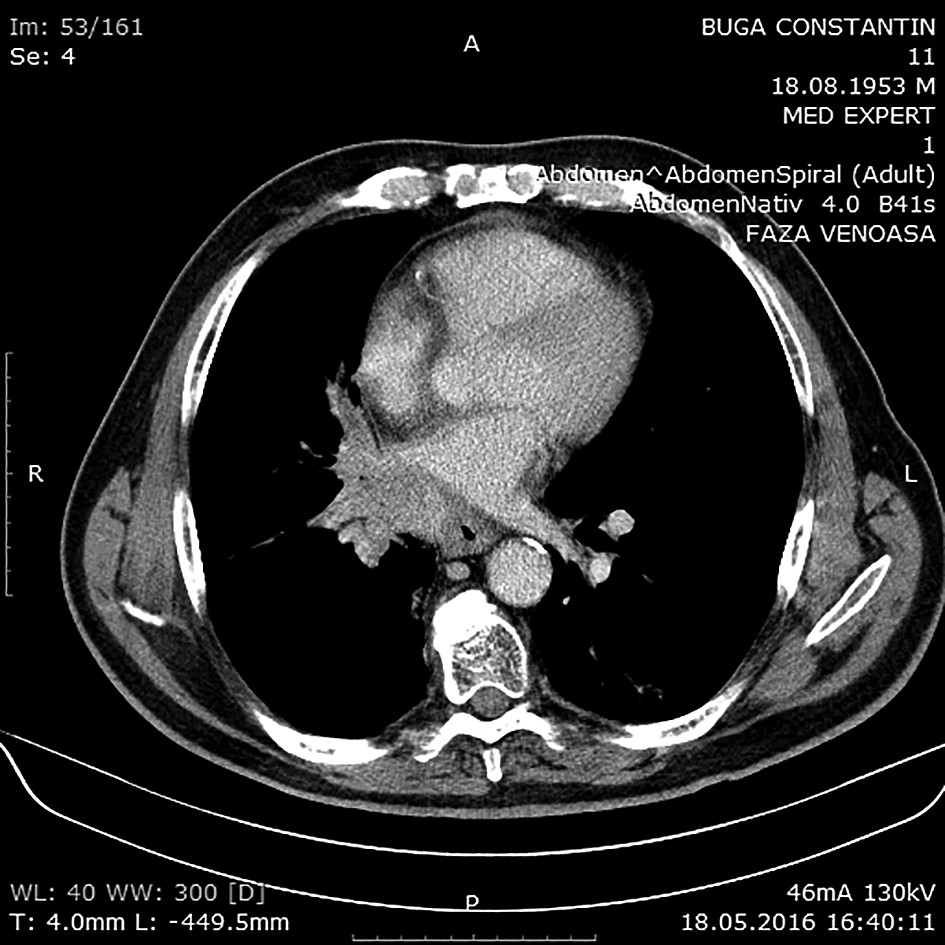
Minimum evolving tumor mass under right hilum described at the CT from 4.02.2016.
Right lateral tracheal lymph nodes, infra hilarious and lodge Baretty with the same diameters as in the CT from 4.02.2016
Other options of treatment
Pembrolizumab (if PD-L1 positive) and nivolumab - other systemic therapy including docetaxel (alone or with ramucirumab) or gemcitabine - ramucirumab is approved for second-line therapy in combination with docetaxel. Afatinib may also be an option for the second-line treatment of patients with advanced squamous NSCLC(3).In conclusion, most researchers estimate the following aspects in the management of squamous NSCLC:
- Gemcitabine - or Taxane-based regimens commonly used remains the standard of care (nab-paclitaxel may be the most active).
- Antiangiogenic strategies are too toxic.
- Pemetrexed is no longer approved for use in this subset.
- Positive Phase III trial with necitumumab, with cisplatin and gemcitabine.
- Several new molecular targets have been identified in this subset of NSCLC.
- New strategies are needed for this large group of patients(4).
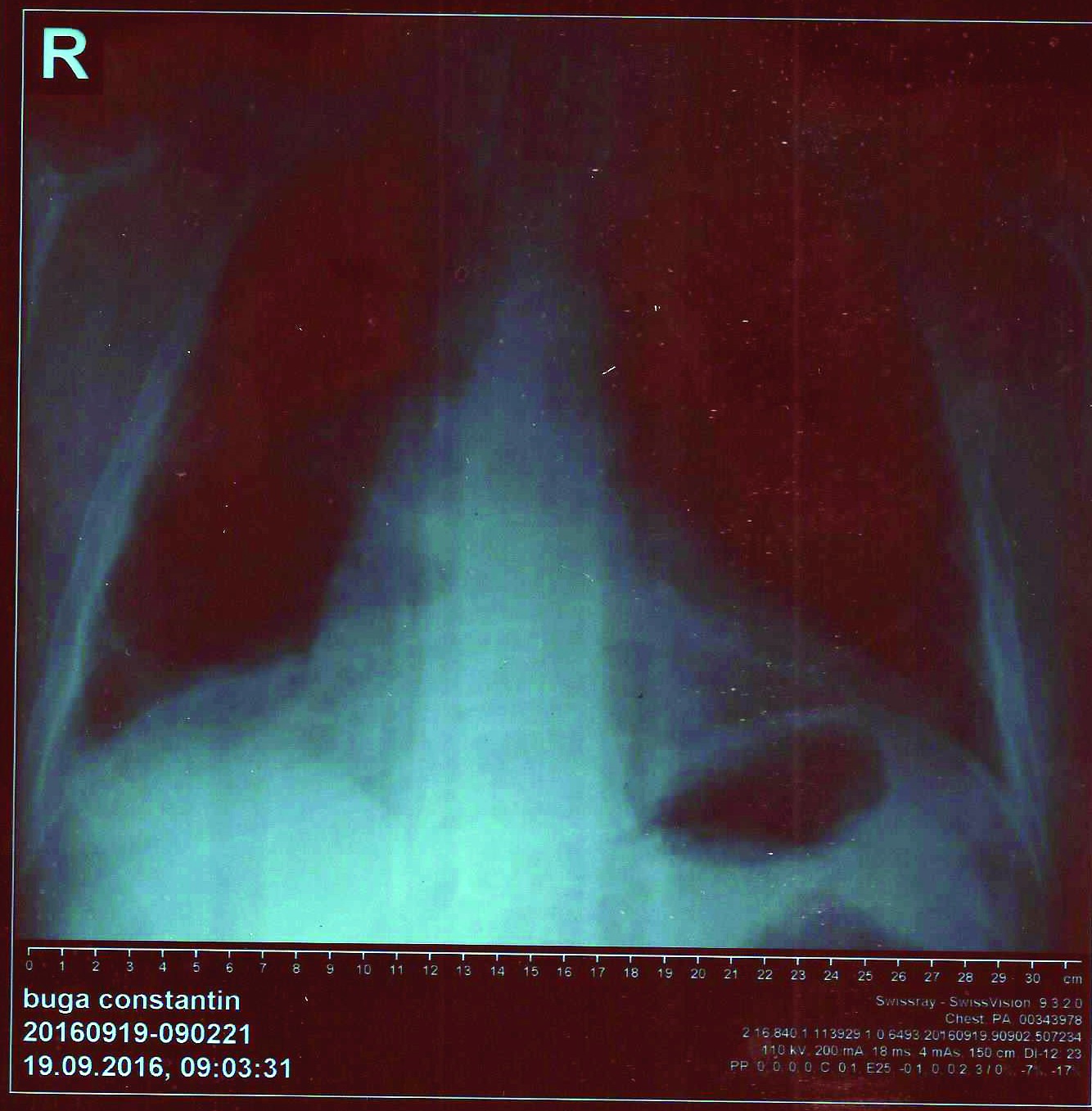
Case particularities
Typical central squamous carcinoma of the lung in a former smoker. Typical response to radiotherapy.
Sensitivity to chemotherapy, including mono chemotherapy with oral Vinorelbine which replaced Docetaxel because of the toxicity induced.
Uncommon sensitivity to erlotinib but that can not yet be demonstrated.
Bibliografie
2. Morgensztern D, et al. Lagging Outcomes for Squamous Cell NSCLC, J Thor Oncol. 2009, vol. 4 pp. 1524.
3. Drilon A, Rekhtman N, Ladanyi M, et al. Squamous-cell carcinomas of the lung: emerging biology, controversies, and the promise of targeted therapy. Lancet Oncol 2012; 13:e418-26.
4. Mark Socinski, https://www.google.ro/?gws_rd=cr&ei=yDH1V972FIWWsg GnoY- QCg#q=Clinical+Challenges+and+Opportunities+in+Squamous+Cell+Carcinoma+Mark+A.+Socinski%2C+MD.
Articole din ediţiile anterioare
Importanţa rebiopsierii pentru detectarea mutaţiei T790M în cancerul pulmonar fără celule mici – prezentare de caz
Lung cancer, the leading cause of mortality worldwide, is comprised in proportion of 80-85% of non-small cell lung carcinoma (NSCLC).
Fighting disease at 83 years old: SARS-CoV-2 survival and response to anti-PD-1 therapy in PD-L1 negative adenocarcinoma of the lung – case report
În timpul pandemiei de COVID-19, supravieţuirea totală medie a pacienţilor cu cancer pulmonar a scăzut de la 7,9 luni la 6,7 luni. În analiza TE...
Symptoms control in patients with advanced lung cancer
Prezentăm un scurt review despre principalele simptome întâlnite în cancerul pulmonar, şi anume dispneea, tusea şi hemoptizia. Un aspect particula...
Abordarea chirurgicala a unui nodul pulmonar solitar la un pacient cu o neoplazie in antecedente
Un nodul pulmonar solitar reprezintă o opacitate radiologică, mai mică de 3 centimetri, înconjurată de parenechim pulmonar normal, fără alte modifi...
